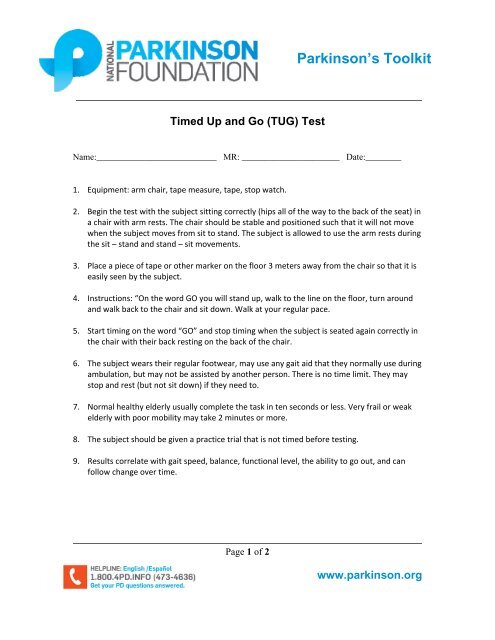

investigated the test – retest reliability of TUG test in a group of patients admitted in inpatient orthopaedic ward (most of them had either total hip or total knee arthroplasty surgery). Previous research suggested that the TUG test had the capacity, in community dwelling people, to predict the patient's ability to go outside alone safely and to function in other settings. Several other studies reported good test-retest reliability of TUG test in specific subject populations, including community-dwelling older adults, individuals with Parkinson’s disease, and unilateral lower-limb amputation. In addition to excellent reliability (ICC 0.99), the TUG scores shown moderate correlation with the Barthel Index ( r −0.51), gait speed ( r −0.55), and the Berg Balance Scale score ( r −0.72). Podsiadlo and Richardson recorded the time taken to complete the TUG in a group of frail elderly subjects with stroke, Parkinson’s disease, arthritis, cerebellar disorders, or general deconditioning. The Timed Up and Go (TUG) test is one of the simple and quick tests to assess patients’ functional mobility. Because a major aim of rehabilitation programs for knee OA is to optimize patients’ functional mobility to carry out their activities of daily living (ADLs), therapist require a valid and reliable tool to assess patients’ functional mobility at baseline and post intervention. The presence of knee pain, decreased functional mobility, stiffness and reduced quadriceps strength has been associated with knee OA and may lead to physical disability. Knee OA is likely to become the eighth most important global cause of disability in men and the fourth most important in women. The evidence of radiographic knee OA has been reported to be 53.3 % in male and 60.9 % in female adults aged 30 – 93 years in the Middle East. Knee osteoarthritis (OA) is a common musculoskeletal disorder affecting the functional mobility of older individuals. The TUG is a reliable test with adequate MDC for clinical use in individuals with doubtful to moderate knee OA. The MDC, based on measurements by a single rater and between raters, was 1.10 and 1.14 seconds, respectively. Intra-rater and inter-rater reliability were 0.97 (95 % confidence interval, 0.95 – 0.98) and 0.96 (95 % confidence interval, 0.94 – 0.97), respectively. The standard error of measurement (SEM) and the minimum detectable change (MDC) were calculated to determine statistically meaningful changes. Intra-rater reliability was assessed on two consecutive visits with a 2-day interval. Inter-rater reliability was assessed using two observers at different times of the same day in an alternating order. Sixty-five subjects (25 male, 40 female), aged 45–70 years, with knee OA participated. The aims of this study were to determine the reliability and minimal detectable change of the TUG test in individuals with doubtful to moderate (Grade 1–3) knee OA. However, its reliability in individuals with knee osteoarthritis (OA) has not been well established. The Timed Up and Go (TUG) test is quick and easy tests to assess patients’ functional mobility.


 0 kommentar(er)
0 kommentar(er)
